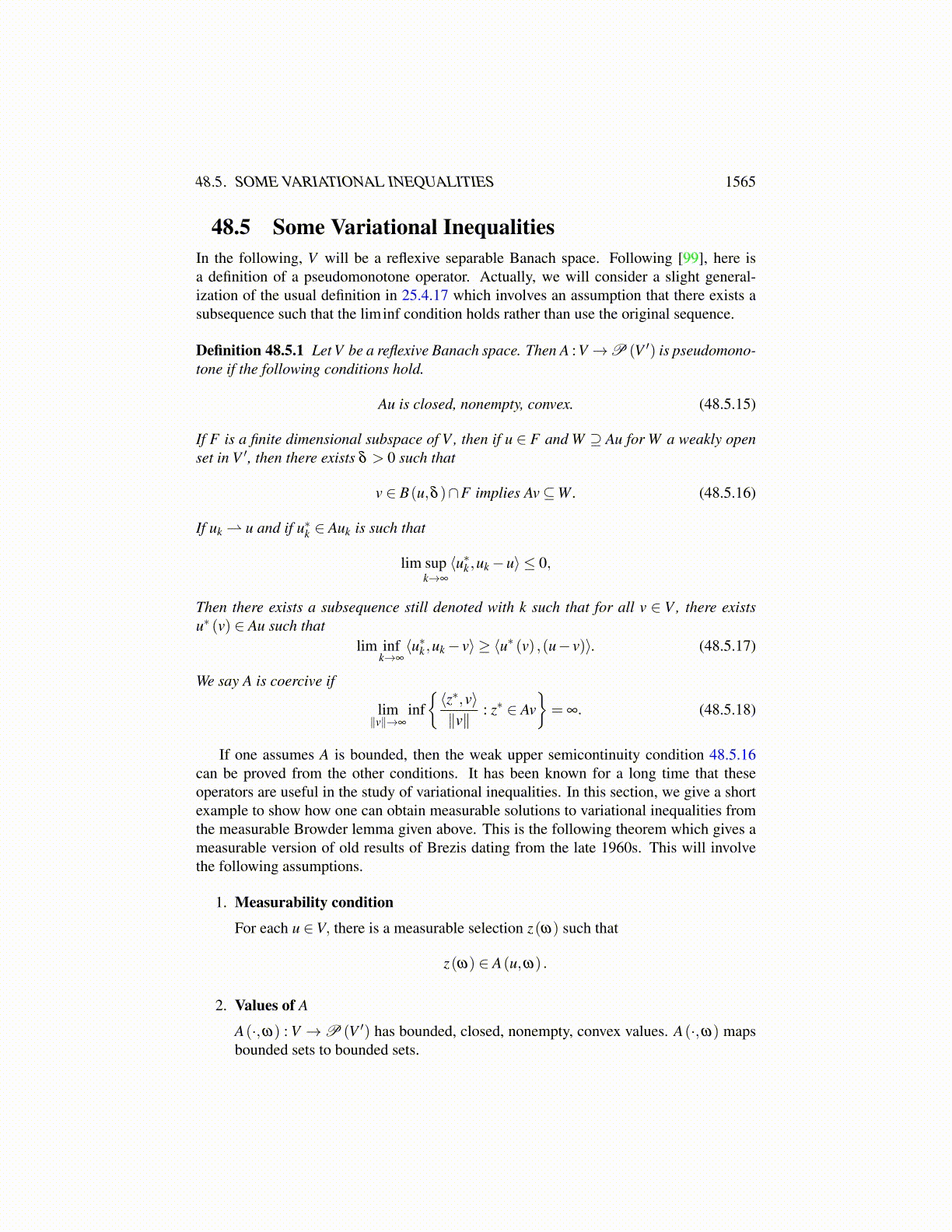
48.4. A MEASURABLE KAKUTANI THEOREM 1565
48.4 A Measurable Kakutani TheoremRecall the Kakutani theorem, Theorem 25.4.4.
Theorem 48.4.1 Let K be a compact convex subset of Rn and let A : K→P (K) such thatAx is a closed convex subset of K and A is upper semicontinuous. Then there exists x suchthat x ∈ Ax. This is the “fixed point”.
Here is a measurable version of this theorem. It is just like the proof of the aboveBrowder lemma.
Theorem 48.4.2 Let K (ω) be compact, convex, and ω → K (ω) a measurable multifunc-tion. Let A(·,ω) : K (ω)→ K (ω) be upper semicontinuous, and let ω → A(x,ω) have ameasurable selection for each x ∈Rn. Then there exists x(ω) ∈ K (ω)∩A(K (ω) ,ω) suchthat ω → x(ω) is measurable.
Proof: Tile Rn with n simplices such that the collection is locally finite and each sim-plex has diameter less than ε < 1. This collection of simplices is determined by a countablecollection of vertices so there exists a one to one and onto map from N to the collectionof vertices. By assumption, for each vertex x, there exists Aε (x,ω) ∈ A
(PK(ω)x,ω
). By
Lemma 48.3.2, ω → PK(ω)x is measurable and by Theorem 48.3.1, there is a measurableselection for ω → A
(PK(ω)x,ω
)which is denoted as Aε (x,ω). By local finiteness, this
function is continuous in x on the set of vertices. Define Aε on all of Rn by the followingrule. If
x ∈ [x0, · · · ,xn],
so x =∑ni=0 tixi, then
Aε (x,ω)≡n
∑k=0
tkAε (xk,ω) .
By local finiteness, this function satisfies ω→Aε (x,ω) is measurable and also x→Aε (x,ε)is continuous. It also maps Rn to K (ω). By Corollary 48.2.14 there is a measurable fixedpoint xε (ω) satisfying xε (ω) ∈ K (ω) and Aε (xε (ω) ,ω) = xε (ω) .
Suppose xε (ω) ∈[xε
0 (ω) , · · · ,xεn (ω)
]so xε (ω) = ∑
nk=0 tε
k (ω)xεk (ω).
claim: The vertices xεk (ω) can be considered measurable also as is tε
k (ω).Proof of claim: Let the simplices in the tiling be {σ k}∞
k=1 and let the vertices of sim-plices in the tiling be
{z j}∞
j=1. Let
Fk := x−1ε (σ k) ,E1 := F1, · · · ,Ek := Fk \∪k
i=1Fi
Then ω is in exactly one of these measurable sets Ek. These measurable sets partition Ω.Let σ k (ω) be the unique simplex for ω ∈ Ek. Thus xε (ω) ∈ σ k (ω) on the measurableset Ek. Its vertices, are zi0 (ω) ,zi1 (ω) , · · · ,zin (ω) . These are xε
0 (ω) , · · · ,xεn (ω) in order.
They are determined in this way on a measurable set so they are measurable Rn valuedfunctions. Then ω → tε
k (ω) is also measurable because there is a continuous mapping tothese scalars from xε (ω) .